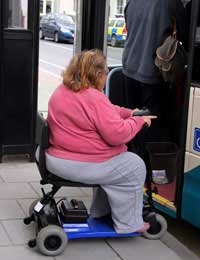Powered Scooters and Wheelchairs to Get You Mobile in Retirement

If walking is proving difficult, powered scooters and wheelchairs can be a godsend. They allow you to be much more mobile than might otherwise have been the case, but they both have their advantages and disadvantages. Here, we offer advice on the two types of mobility equipment.
Using Powered Scooters and Wheelchairs on the Pavement
There are two types of powered scooters and wheelchairs: those that are designed to be used on the pavement, and those that are designed to be used on the road, as well as on the pavement. The pavement-only types have a top speed of 4 miles per hour, while the road types are slightly faster and can reach 8 miles per hour.When using powered scooters and wheelchairs on the pavement, you must give way to pedestrians, as they have the right of way. You must not exceed the 4 miles per hour speed limit, particularly where pedestrians are present as they may not be able to get out of the way before you can slow down.
When crossing roads, always make sure that it's safe for you to leave the pavement before you. Use dropped kerbs whenever possible as these make it easier for the scooter or wheelchair to negotiate the transition.
Using Powered Scooters and Wheelchairs on the Road
Using the pavement is the best option, but if this is not possible, there are some basic rules you should follow when using your powered scooter or wheelchair on the roads.
As you will be going much more slowly than the vast majority of the other vehicles on the road, you need to be extra careful to avoid accidents. Follow the general flow of the traffic so that other vehicles are running in front, behind and alongside you in the same direction as you, instead of coming towards you.
If you're travelling at night, you must switch on your lights (if your scooter or wheelchair has these). It's not uncommon for other roads users to find it more difficult to see you, so lights are necessary for safety purposes. For the same reason, reflective safety clothing is advisable.
When approaching major roundabouts and junctions, it's safer to go back on the pavement. If this isn't impossible, stick to the left-hand side of the road until a safe gap emerges in the traffic. Some junctions will simply be too dangerous to safely negotiate, in which case planning an alternative route can provide a better option.
Using Powered Scooters and Wheelchairs on the Motorway
Powered scooters and wheelchairs are not allowed on motorways (or on unrestricted dual carriageways with a speed limit of more than 50 miles per hour unless you're displaying a flashing amber beacon to alert other road users to your presence). On all other dual carriageways, the flashing amber beacon must be visible.
Parking Powered Scooters and Wheelchairs
Parking a powered scooter or wheelchair is much the same as parking any other vehicle. You can get concessions under the Blue Badge Scheme (see our article on this for more details).
Powered scooters and wheelchairs make life a lot easier if you're finding it difficult to get around, but you need to be aware of the basic rules of using them to stay safe.
- Getting About in Bad Weather Once You've Retired
- Staying in Touch With Family and Managing Visits
- Quiz: Are You Safe to Continue Driving in Old Age?
- Taking Mobility Equipment On Public Transport
- Travelling Abroad With Mobility Problems
- Considerations When Driving in Retirement
- Having a Car Adapted to Suit Your Needs
- Parking and the Blue Badge Scheme
- Servicing, Taxing and Insurance Your Vehicle in Retirement
- Car Purchasing and the Motability Scheme


Re: Financing and Grants for Home Mobility Equipment
My partner is suffering from copd, sarcoidosis, bronchiectasis and pulmonary fibrosis.. She is finding…
Re: Financing and Grants for Home Mobility Equipment
Hi I have lost the use of my right hand which had operations for carpal tunnel trigger finger seemingly…
Re: Financing and Grants for Home Mobility Equipment
Hello my dad get a mobility car to help get around, He wounding do you think he could get a mobility…
Re: Financing and Grants for Home Mobility Equipment
My problem is both my Knees have failed there MOT,I spent 11days in Hospital as I couldn't Put any…
Re: Financing and Grants for Home Mobility Equipment
I was diagnosed with Fibromyalgia over 23 years ago. Nobody believed me, my children as well as doctors.…
Re: Financing and Grants for Home Mobility Equipment
I have been trying to get help for a bath put In I carnt get none anywere I cannot use the shower it…
Re: The Benefits of Keeping an Active Mind
sir ,my mind remmber well about some time not remmber any thing what process that wi;ll i do
Re: Financing and Grants Available for Transport In Retirement
My dad keeps losing balance on his legs done have much money he needs a mobility scooter…
Re: Financing and Grants Available for Transport In Retirement
I have just come out of hospital. I have astma and very difficult to walk .I can not go out…
Re: Financing and Grants for Home Mobility Equipment
Kaza - Your Question:I av arthritis in both knees and in my right hand and index finger. I need help to…